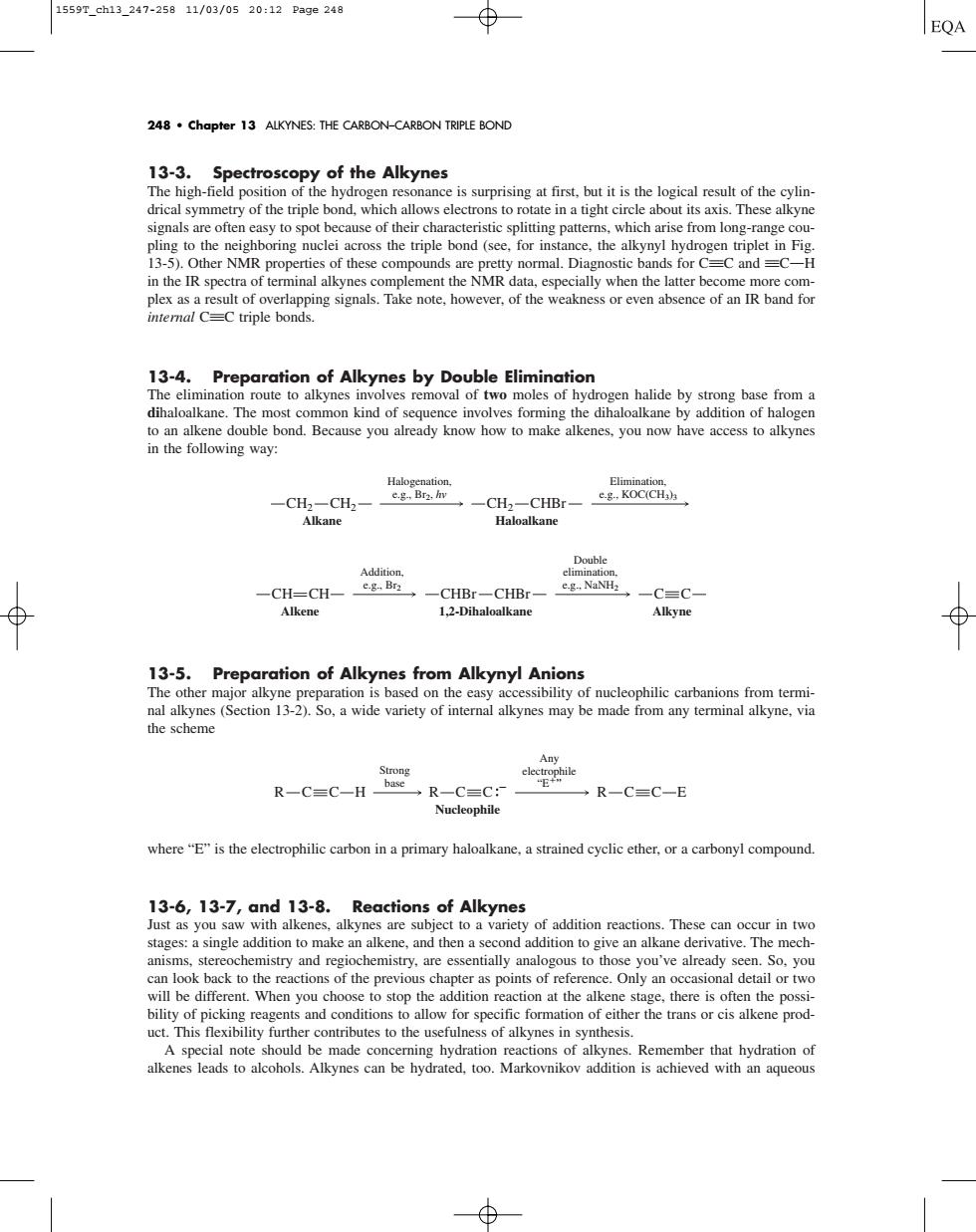正在加载图片...

15597.ch13247-25811/02/0520:12Page248 EQA 248.Chapter 13 ALKYNES:THE CARBON-CARBON TRIPLE BOND 13-3 Spectroscopy of the Alkynes signals are often easy to spot because of their characteristic splitting pattems.which arise from long-range cou 风gnR 13-4.Preparation of Alkynes by Double Elimination route to alkynes involves removal of two moles of hydrogen halide by strong base from a you now d in the following way: -CH2-CHBrKCCo Alkane Haloalkane -CH-CH-- CHB:CHBr- -C=C- Alken Alkyn Preparation of Alkynes from Alkynyl Anior ibility of nucleophilic carbanic naalynes (Sction -).ie variety of ine alkynes y be made ry y.v the scheme R-Cec-H →R一C=C-E whereE"is the electrophilic carbon ina primary haloalkane.a strained cyclic ether.ora carbonyl compound 13-6,13-7,and 13-8.Reactions of Alkynes aeingle addition to mae alkee and theadinalan erivThmec anisms.stereochemistry and regiochemistry.are essentially analogous to those you've already seen.So.you ck to uct.This flexibility contributes to the usefuln s of alkynes in synthesis13-3. Spectroscopy of the Alkynes The high-field position of the hydrogen resonance is surprising at first, but it is the logical result of the cylindrical symmetry of the triple bond, which allows electrons to rotate in a tight circle about its axis. These alkyne signals are often easy to spot because of their characteristic splitting patterns, which arise from long-range coupling to the neighboring nuclei across the triple bond (see, for instance, the alkynyl hydrogen triplet in Fig. 13-5). Other NMR properties of these compounds are pretty normal. Diagnostic bands for CqC and qCOH in the IR spectra of terminal alkynes complement the NMR data, especially when the latter become more complex as a result of overlapping signals. Take note, however, of the weakness or even absence of an IR band for internal CqC triple bonds. 13-4. Preparation of Alkynes by Double Elimination The elimination route to alkynes involves removal of two moles of hydrogen halide by strong base from a dihaloalkane. The most common kind of sequence involves forming the dihaloalkane by addition of halogen to an alkene double bond. Because you already know how to make alkenes, you now have access to alkynes in the following way: 13-5. Preparation of Alkynes from Alkynyl Anions The other major alkyne preparation is based on the easy accessibility of nucleophilic carbanions from terminal alkynes (Section 13-2). So, a wide variety of internal alkynes may be made from any terminal alkyne, via the scheme where “E” is the electrophilic carbon in a primary haloalkane, a strained cyclic ether, or a carbonyl compound. 13-6, 13-7, and 13-8. Reactions of Alkynes Just as you saw with alkenes, alkynes are subject to a variety of addition reactions. These can occur in two stages: a single addition to make an alkene, and then a second addition to give an alkane derivative. The mechanisms, stereochemistry and regiochemistry, are essentially analogous to those you’ve already seen. So, you can look back to the reactions of the previous chapter as points of reference. Only an occasional detail or two will be different. When you choose to stop the addition reaction at the alkene stage, there is often the possibility of picking reagents and conditions to allow for specific formation of either the trans or cis alkene product. This flexibility further contributes to the usefulness of alkynes in synthesis. A special note should be made concerning hydration reactions of alkynes. Remember that hydration of alkenes leads to alcohols. Alkynes can be hydrated, too. Markovnikov addition is achieved with an aqueous Strong base Any electrophile “E” R Nucleophile R C C H C C R C C E Addition, e.g., Br2 Double elimination, e.g., NaNH2 CH CH CHBr CHBr Alkene 1,2-Dihaloalkane C C Alkyne Halogenation, e.g., Br2, hv Elimination, e.g., KOC(CH3)3 CH2 CH2 CH2 CHBr Alkane Haloalkane 248 • Chapter 13 ALKYNES: THE CARBON–CARBON TRIPLE BOND 1559T_ch13_247-258 11/03/05 20:12 Page 248�